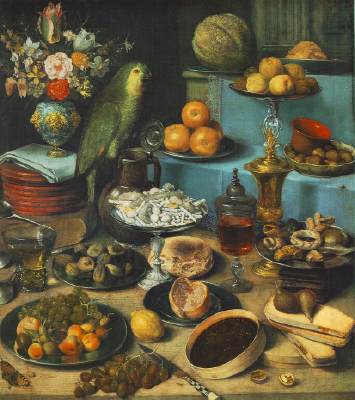Still-life with Parrot
Georg Flegel, ca. 1600
Georg Flegel, ca. 1600
This week I've chosen a German painting full of sweets and such.
Like most still-life paintings, there's a bunch of interesting things scattered about. At the front and just to the right is a round wooden box that is filled with what's probably quince paste (cotignac or membrillo - like marmalade but much more firm, if you haven't tried this stuff then look at the local gourmet grocery, they usually have it near the imported cheeses like manchego - with which it goes exceptionally well!).
I'd be tempted to call the flat things in the lower right trenchers, but by the 1600s the use of trenchers had pretty much fallen out of fashion. They look more like biscotti (zweibaken? my German is not that good). Those things on top are either small pears or (more likely, I think) fresh figs.
The tall silver dish in the center is filled with sugar-covered things. I imagine the stick-shaped ones are strips of orange peel or maybe even horseradish root. I have no idea what the other things are, though the smaller, oval things might be almonds. Notice how nice and white the sugar coating is? I've ranted about the color of medieval sugar before. On a side note, the bumpiness of the sugared items is caused by having the sugar syrup too hot during the coating process. Around the dish of sweets is a plate of dried figs (maybe with some dates as well), a pomegranate, and a small (about 1/4 pound) loaf of bread.
On the left, near the spoons, is a beautiful prunted beaker - I have a set that look almost exactly like it. Behind and under the stack of plates is what looks like a wheel of cheese. I really hope the color of the paint has changed over the centuries, because that's not the color I like my cheese to have.
It wouldn't be that hard to re-create this setup, though I'd cover the table with a nice cloth. I'd also leave out the parrot - I'm sure it's a health code violation.





















